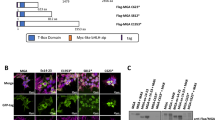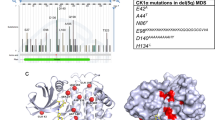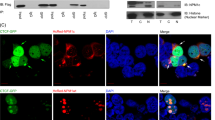Abstract
The AML1 transcription factor complex is the most frequent target of leukemia-associated chromosomal translocations. Homeodomain-interacting protein kinase 2 (HIPK2) is a part of the AML1 complex and activates AML1-mediated transcription. However, chromosomal translocations and mutations of HIPK2 have not been reported. In the current study, we screened mutations of the HIPK2 gene in 50 cases of acute myeloid leukemia (AML) and in 80 cases of myelodysplastic syndrome (MDS). Results indicated there were two missense mutations (R868W and N958I) in the speckle-retention signal (SRS) domain of HIPK2. Subcellular localization analyses indicated that the two mutants were largely localized to nuclear regions with conical or ring shapes, and were somewhat diffused in the nucleus, in contrast to the wild type, which were mainly localized in nuclear speckles. The mutations impaired the overlapping localization of AML1 and HIPK2. The mutants showed decreased activities and a dominant-negative function over wild-type protein in AML1- and p53-dependent transcription. These findings suggest that dysfunction of HIPK2 may play a role in the pathogenesis of leukemia.
This is a preview of subscription content, access via your institution
Access options
Subscribe to this journal
Receive 50 print issues and online access
$259.00 per year
only $5.18 per issue
Buy this article
- Purchase on Springer Link
- Instant access to full article PDF
Prices may be subject to local taxes which are calculated during checkout







Similar content being viewed by others
References
Aikawa Y, Nguyen LA, Isono K, Takakura N, Tagata Y, Schmitz ML et al. (2006). Roles of HIPK1 and HIPK2 in AML1- and p300-dependent transcription, hematopoiesis and blood vessel formation. EMBO J 25: 3955–3965.
Borrow J, Stanton Jr VP, Andresen JM, Becher R, Behm FG, Chaganti RS et al. (1996). The translocation t(8;16)(p11;p13) of acute myeloid leukaemia fuses a putative acetyltransferase to the CREB-binding protein. Nat Genet 14: 33–41.
Carapeti M, Aguiar RC, Goldman JM, Cross NC . (1998). A novel fusion between MOZ and the nuclear receptor coactivator TIF2 in acute myeloid leukemia. Blood 91: 3127–3133.
Carapeti M, Aguiar RC, Watmore AE, Goldman JM, Cross NC . (1999). Consistent fusion of MOZ and TIF2 in AML with inv(8)(p11q13). Cancer Genet Cytogenet 113: 70–72.
Chaffanet M, Gressin L, Preudhomme C, Soenen-Cornu V, Birnbaum D, Pebusque MJ . (2000). MOZ is fused to p300 in an acute monocytic leukemia with t(8;22). Genes Chromosomes Cancer 28: 138–144.
Choi CY, Kim YH, Kwon HJ, Kim Y . (1999). The homeodomain protein NK-3 recruits Groucho and a histone deacetylase complex to repress transcription. J Biol Chem 274: 33194–33197.
D'Orazi G, Cecchinelli B, Bruno T, Manni I, Higashimoto Y, Saito S et al. (2002). Homeodomain-interacting protein kinase-2 phosphorylates p53 at Ser 46 and mediates apoptosis. Nat Cell Biol 4: 11–19.
de The H, Lavau C, Marchio A, Chomienne C, Degos L, Dejean A . (1991). The PML-RAR alpha fusion mRNA generated by the t(15;17) translocation in acute promyelocytic leukemia encodes a functionally altered RAR. Cell 66: 675–684.
de The H, Vivanco-Ruiz MM, Tiollais P, Stunnenberg H, Dejean A . (1990). Identification of a retinoic acid responsive element in the retinoic acid receptor beta gene. Nature 343: 177–180.
Duprez E, Saurin AJ, Desterro JM, Lallemand-Breitenbach V, Howe K, Boddy MN et al. (1999). SUMO-1 modification of the acute promyelocytic leukaemia protein PML: implications for nuclear localisation. J Cell Sci 112 (Part 3): 381–393.
Engelhardt OG, Boutell C, Orr A, Ullrich E, Haller O, Everett RD . (2003). The homeodomain-interacting kinase PKM (HIPK-2) modifies ND10 through both its kinase domain and a SUMO-1 interaction motif and alters the posttranslational modification of PML. Exp Cell Res 283: 36–50.
Gamou T, Kitamura E, Hosoda F, Shimizu K, Shinohara K, Hayashi Y et al. (1998). The partner gene of AML1 in t(16;21) myeloid malignancies is a novel member of the MTG8(ETO) family. Blood 91: 4028–4037.
Golub TR, Barker GF, Bohlander SK, Hiebert SW, Ward DC, Bray-Ward P et al. (1995). Fusion of the TEL gene on 12p13 to the AML1 gene on 21q22 in acute lymphoblastic leukemia. Proc Natl Acad Sci USA 92: 4917–4921.
Harada H, Harada Y, Niimi H, Kyo T, Kimura A, Inaba T . (2004). High incidence of somatic mutations in the AML1/RUNX1 gene in myelodysplastic syndrome and low blast percentage myeloid leukemia with myelodysplasia. Blood 103: 2316–2324.
Hofmann TG, Jaffray E, Stollberg N, Hay RT, Will H . (2005). Regulation of homeodomain-interacting protein kinase 2 (HIPK2) effector function through dynamic small ubiquitin-related modifier-1 (SUMO-1) modification. J Biol Chem 280: 29224–29232.
Hofmann TG, Mincheva A, Lichter P, Droge W, Schmitz ML . (2000). Human homeodomain-interacting protein kinase-2 (HIPK2) is a member of the DYRK family of protein kinases and maps to chromosome 7q32-q34. Biochimie 82: 1123–1127.
Hofmann TG, Moller A, Sirma H, Zentgraf H, Taya Y, Droge W et al. (2002). Regulation of p53 activity by its interaction with homeodomain-interacting protein kinase-2. Nat Cell Biol 4: 1–10.
Hofmann TG, Stollberg N, Schmitz ML, Will H . (2003). HIPK2 regulates transforming growth factor-beta-induced c-Jun NH(2)-terminal kinase activation and apoptosis in human hepatoma cells. Cancer Res 63: 8271–8277.
Ida K, Kitabayashi I, Taki T, Taniwaki M, Noro K, Yamamoto M et al. (1997). Adenoviral E1A-associated protein p300 is involved in acute myeloid leukemia with t(11;22)(q23;q13). Blood 90: 4699–4704.
Imai Y, Kurokawa M, Izutsu K, Hangaishi A, Takeuchi K, Maki K et al. (2000). Mutations of the AML1 gene in myelodysplastic syndrome and their functional implications in leukemogenesis. Blood 96: 3154–3160.
Kakizuka A, Miller Jr WH, Umesono K, Warrell Jr RP, Frankel SR, Murty VV et al. (1991). Chromosomal translocation t(15;17) in human acute promyelocytic leukemia fuses RAR alpha with a novel putative transcription factor, PML. Cell 66: 663–674.
Kamitani T, Kito K, Nguyen HP, Wada H, Fukuda-Kamitani T, Yeh ET . (1998). Identification of three major sentrinization sites in PML. J Biol Chem 273: 26675–26682.
Kastner P, Perez A, Lutz Y, Rochette-Egly C, Gaub MP, Durand B et al. (1992). Structure, localization and transcriptional properties of two classes of retinoic acid receptor alpha fusion proteins in acute promyelocytic leukemia (APL): structural similarities with a new family of oncoproteins. EMBO J 11: 629–642.
Kim YH, Choi CY, Kim Y . (1999). Covalent modification of the homeodomain-interacting protein kinase 2 (HIPK2) by the ubiquitin-like protein SUMO-1. Proc Natl Acad Sci USA 96: 12350–12355.
Kim YH, Choi CY, Lee SJ, Conti MA, Kim Y . (1998). Homeodomain-interacting protein kinases, a novel family of co-repressors for homeodomain transcription factors. J Biol Chem 273: 25875–25879.
Kim YH, Sung KS, Lee SJ, Kim YO, Choi CY, Kim Y . (2005). Desumoylation of homeodomain-interacting protein kinase 2 (HIPK2) through the cytoplasmic-nuclear shuttling of the SUMO-specific protease SENP1. FEBS Lett 579: 6272–6278.
Kitabayashi I, Aikawa Y, Nguyen LA, Yokoyama A, Ohki M . (2001a). Activation of AML1-mediated transcription by MOZ and inhibition by the MOZ-CBP fusion protein. EMBO J 20: 7184–7196.
Kitabayashi I, Aikawa Y, Yokoyama A, Hosoda F, Nagai M, Kakazu N et al. (2001b). Fusion of MOZ and p300 histone acetyltransferases in acute monocytic leukemia with a t(8;22)(p11;q13) chromosome translocation. Leukemia 15: 89–94.
Kitabayashi I, Yokoyama A, Shimizu K, Ohki M . (1998). Interaction and functional cooperation of the leukemia-associated factors AML1 and p300 in myeloid cell differentiation. EMBO J 17: 2994–3004.
Krug U, Ganser A, Koeffler HP . (2002). Tumor suppressor genes in normal and malignant hematopoiesis. Oncogene 21: 3475–3495.
Lin X, Sun B, Liang M, Liang YY, Gast A, Hildebrand J et al. (2003). Opposed regulation of corepressor CtBP by SUMOylation and PDZ binding. Mol Cell 11: 1389–1396.
Mahajan R, Delphin C, Guan T, Gerace L, Melchior F . (1997). A small ubiquitin-related polypeptide involved in targeting RanGAP1 to nuclear pore complex protein RanBP2. Cell 88: 97–107.
Matunis MJ, Coutavas E, Blobel G . (1996). A novel ubiquitin-like modification modulates the partitioning of the Ran-GTPase-activating protein RanGAP1 between the cytosol and the nuclear pore complex. J Cell Biol 135: 1457–1470.
Matunis MJ, Wu J, Blobel G . (1998). SUMO-1 modification and its role in targeting the Ran GTPase-activating protein, RanGAP1, to the nuclear pore complex. J Cell Biol 140: 499–509.
Meyers S, Downing JR, Hiebert SW . (1993). Identification of AML-1 and the (8;21) translocation protein (AML-1/ETO) as sequence-specific DNA-binding proteins: the runt homology domain is required for DNA binding and protein-protein interactions. Mol Cell Biol 13: 6336–6345.
Mitani K, Ogawa S, Tanaka T, Miyoshi H, Kurokawa M, Mano H et al. (1994). Generation of the AML1-EVI-1 fusion gene in the t(3;21)(q26;q22) causes blastic crisis in chronic myelocytic leukemia. EMBO J 13: 504–510.
Mitelman F, Mertens F, Johansson B . (1997). A breakpoint map of recurrent chromosomal rearrangements in human neoplasia. Nat Genet 15: 417–474.
Miyoshi H, Shimizu K, Kozu T, Maseki N, Kaneko Y, Ohki M . (1991). t(8;21) breakpoints on chromosome 21 in acute myeloid leukemia are clustered within a limited region of a single gene, AML1. Proc Natl Acad Sci USA 88: 10431–10434.
Moller A, Sirma H, Hofmann TG, Rueffer S, Klimczak E, Droge W et al. (2003a). PML is required for homeodomain-interacting protein kinase 2 (HIPK2)-mediated p53 phosphorylation and cell cycle arrest but is dispensable for the formation of HIPK domains. Cancer Res 63: 4310–4314.
Moller A, Sirma H, Hofmann TG, Staege H, Gresko E, Ludi KS et al. (2003b). Sp100 is important for the stimulatory effect of homeodomain-interacting protein kinase-2 on p53-dependent gene expression. Oncogene 22: 8731–8737.
Nguyen LA, Pandolfi PP, Aikawa Y, Tagata Y, Ohki M, Kitabayashi I . (2005). Physical and functional link of the leukemia-associated factors AML1 and PML. Blood 105: 292–300.
Nucifora G, Begy CR, Erickson P, Drabkin HA, Rowley JD . (1993). The 3;21 translocation in myelodysplasia results in a fusion transcript between the AML1 gene and the gene for EAP, a highly conserved protein associated with the Epstein-Barr virus small RNA EBER 1. Proc Natl Acad Sci USA 90: 7784–7788.
Ogawa E, Maruyama M, Kagoshima H, Inuzuka M, Lu J, Satake M et al. (1993). PEBP2/PEA2 represents a family of transcription factors homologous to the products of the Drosophila runt gene and the human AML1 gene. Proc Natl Acad Sci USA 90: 6859–6863.
Okada H, Watanabe T, Niki M, Takano H, Chiba N, Yanai N et al. (1998). AML1(−/−) embryos do not express certain hematopoiesis-related gene transcripts including those of the PU.1 gene. Oncogene 17: 2287–2293.
Okuda T, van Deursen J, Hiebert SW, Grosveld G, Downing JR . (1996). AML1, the target of multiple chromosomal translocations in human leukemia, is essential for normal fetal liver hematopoiesis. Cell 84: 321–330.
Osato M, Asou N, Abdalla E, Hoshino K, Yamasaki H, Okubo T et al. (1999). Biallelic and heterozygous point mutations in the runt domain of the AML1/PEBP2alphaB gene associated with myeloblastic leukemias. Blood 93: 1817–1824.
Pierantoni GM, Fedele M, Pentimalli F, Benvenuto G, Pero R, Viglietto G et al. (2001). High mobility group I (Y) proteins bind HIPK2, a serine-threonine kinase protein which inhibits cell growth. Oncogene 20: 6132–6141.
Preudhomme C, Warot-Loze D, Roumier C, Grardel-Duflos N, Garand R, Lai JL et al. (2000). High incidence of biallelic point mutations in the Runt domain of the AML1/PEBP2 alpha B gene in Mo acute myeloid leukemia and in myeloid malignancies with acquired trisomy 21. Blood 96: 2862–2869.
Romana SP, Mauchauffe M, Le Coniat M, Chumakov I, Le Paslier D, Berger R et al. (1995). The t(12;21) of acute lymphoblastic leukemia results in a tel-AML1 gene fusion. Blood 85: 3662–3670.
Rui Y, Xu Z, Lin S, Li Q, Rui H, Luo W et al. (2004). Axin stimulates p53 functions by activation of HIPK2 kinase through multimeric complex formation. EMBO J 23: 4583–4594.
Sasaki K, Yagi H, Bronson RT, Tominaga K, Matsunashi T, Deguchi K et al. (1996). Absence of fetal liver hematopoiesis in mice deficient in transcriptional coactivator core binding factor beta. Proc Natl Acad Sci USA 93: 12359–12363.
Satake N, Ishida Y, Otoh Y, Hinohara S, Kobayashi H, Sakashita A et al. (1997). Novel MLL-CBP fusion transcript in therapy-related chronic myelomonocytic leukemia with a t(11;16)(q23;p13) chromosome translocation. Genes Chromosomes Cancer 20: 60–63.
Sobulo OM, Borrow J, Tomek R, Reshmi S, Harden A, Schlegelberger B et al. (1997). MLL is fused to CBP, a histone acetyltransferase, in therapy-related acute myeloid leukemia with a t(11;16)(q23;p13.3). Proc Natl Acad Sci USA 94: 8732–8737.
Sung KS, Go YY, Ahn JH, Kim YH, Kim Y, Choi CY . (2005). Differential interactions of the homeodomain-interacting protein kinase 2 (HIPK2) by phosphorylation-dependent sumoylation. FEBS Lett 579: 3001–3008.
Taki T, Sako M, Tsuchida M, Hayashi Y . (1997). The t(11;16)(q23;p13) translocation in myelodysplastic syndrome fuses the MLL gene to the CBP gene. Blood 89: 3945–3950.
Tomasini R, Samir AA, Carrier A, Isnardon D, Cecchinelli B, Soddu S et al. (2003). TP53INP1s and homeodomain-interacting protein kinase-2 (HIPK2) are partners in regulating p53 activity. J Biol Chem 278: 37722–37729.
Wang Q, Stacy T, Binder M, Marin-Padilla M, Sharpe AH, Speck NA . (1996a). Disruption of the Cbfa2 gene causes necrosis and hemorrhaging in the central nervous system and blocks definitive hematopoiesis. Proc Natl Acad Sci USA 93: 3444–3449.
Wang Q, Stacy T, Miller JD, Lewis AF, Gu TL, Huang X et al. (1996b). The CBFbeta subunit is essential for CBFalpha2 (AML1) function in vivo. Cell 87: 697–708.
Wang Y, Hofmann TG, Runkel L, Haaf T, Schaller H, Debatin K et al. (2001). Isolation and characterization of cDNAs for the protein kinase HIPK2. Biochim Biophys Acta 1518: 168–172.
Wiggins AK, Wei G, Doxakis E, Wong C, Tang AA, Zang K et al. (2004). Interaction of Brn3a and HIPK2 mediates transcriptional repression of sensory neuron survival. J Cell Biol 167: 257–267.
Zhang Q, Nottke A, Goodman RH . (2005). Homeodomain-interacting protein kinase-2 mediates CtBP phosphorylation and degradation in UV-triggered apoptosis. Proc Natl Acad Sci USA 102: 2802–2807.
Zhang Q, Yoshimatsu Y, Hildebrand J, Frisch SM, Goodman RH . (2003). Homeodomain interacting protein kinase 2 promotes apoptosis by downregulating the transcriptional corepressor CtBP. Cell 115: 177–186.
Author information
Authors and Affiliations
Corresponding author
Additional information
Supplementary Information accompanies the paper on the Oncogene Web site (http://www.nature.com/onc).
Rights and permissions
About this article
Cite this article
Li, XL., Arai, Y., Harada, H. et al. Mutations of the HIPK2 gene in acute myeloid leukemia and myelodysplastic syndrome impair AML1- and p53-mediated transcription. Oncogene 26, 7231–7239 (2007). https://doi.org/10.1038/sj.onc.1210523
Received:
Revised:
Accepted:
Published:
Issue Date:
DOI: https://doi.org/10.1038/sj.onc.1210523
Keywords
This article is cited by
-
Role of microRNAs, circRNAs and long noncoding RNAs in acute myeloid leukemia
Journal of Hematology & Oncology (2019)
-
HIPK2 and extrachromosomal histone H2B are separately recruited by Aurora-B for cytokinesis
Oncogene (2018)
-
Profiling and functional analysis of circular RNAs in acute promyelocytic leukemia and their dynamic regulation during all-trans retinoic acid treatment
Cell Death & Disease (2018)
-
Role of HIPK2 in kidney fibrosis
Kidney International Supplements (2014)
-
Posttranslational modifications regulate HIPK2, a driver of proliferative diseases
Journal of Molecular Medicine (2013)



